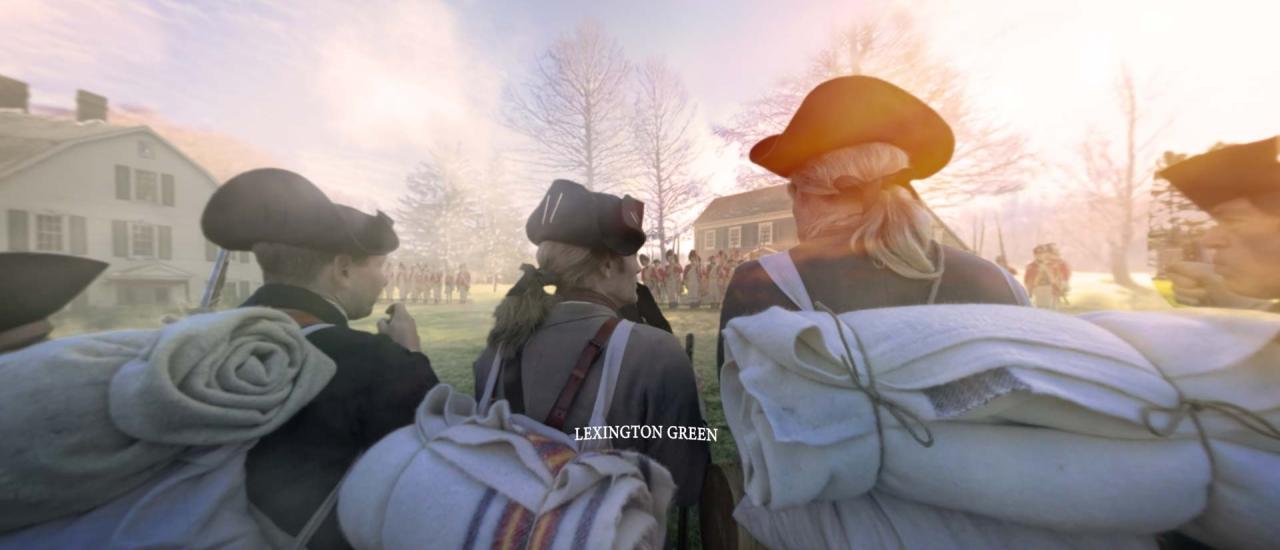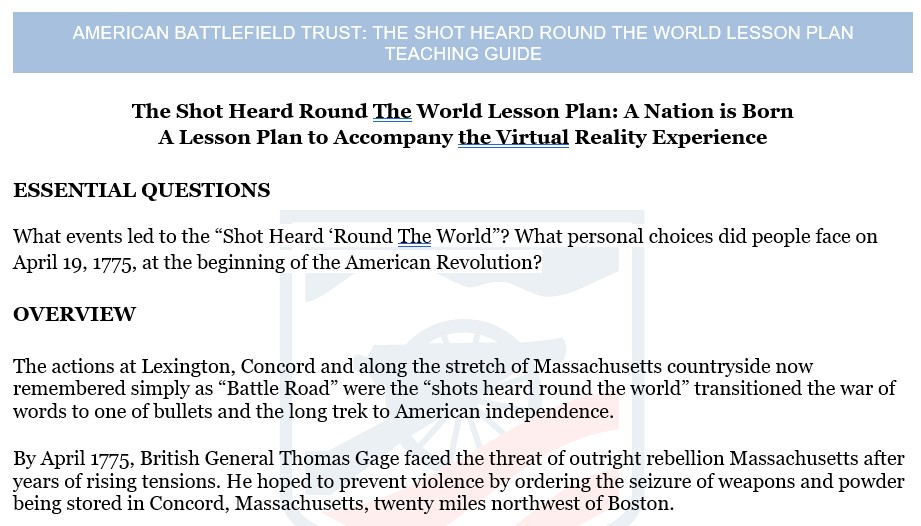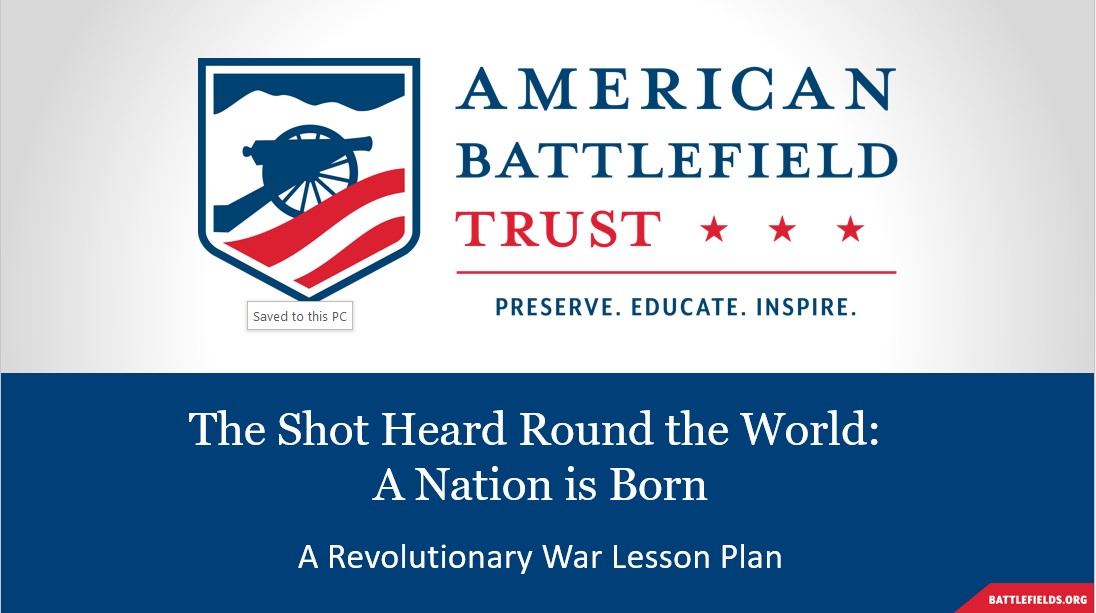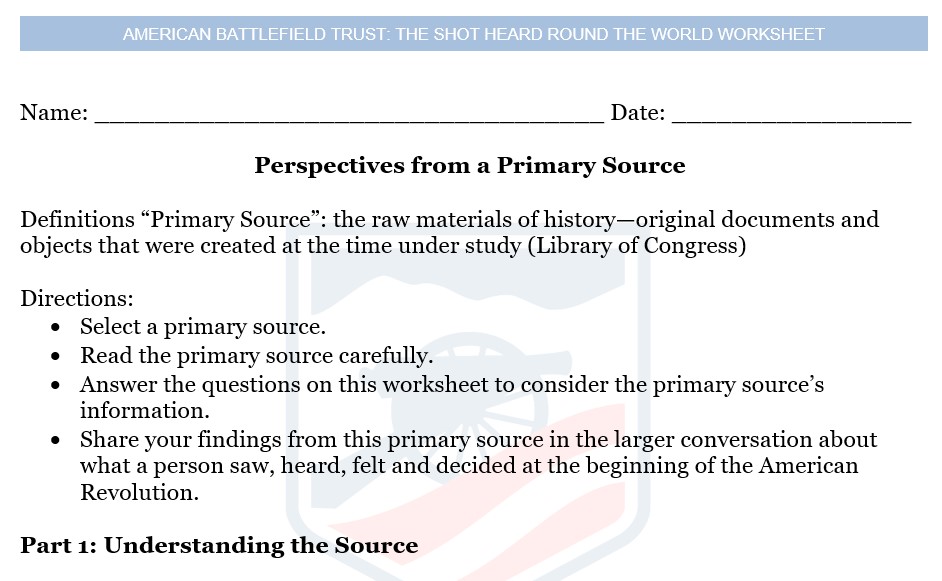
The Shot Heard Round The World Lesson Plan
A lesson plan to accompany the American Battlefield Trust's Virtual Reality Experience.
The actions at Lexington, Concord and along the stretch of Massachusetts countryside now remembered simply as “Battle Road” were the “shots heard round the world” transitioned the war of words to one of bullets and the long trek to American independence.
Use this lesson plan to expand your students' learning with the American Battlefield Trust's Virtual Reality Experience The Shot Heard Round The World: A Nation is Born.
This Lesson Plan can be used as a prepared resource by following this curriculum plan which aligns to NCSS and Common Core Standards for Middle and High School.
Upon completion of this lesson, the students will be able to:
1. Knowledge
- Briefly explain the events at Lexington and Concord on April 19, 1775, that started the American Revolution.
2. Comprehension/Application/Analysis
- Study a primary source and note what the writer heard, saw, and felt on April 19, 1775.
3. Evaluation
- Discuss the choices that different people faced or made during the Battle of Lexington and Concord and how these individual choices shaped the American Revolution and pursuit of liberty.
Check out the Lesson Plan Teaching Guide for more instructions on using the prepared Lesson Plan.
Lesson Plan Primary Source Activity:
- Watch the Virtual Reality Experience video.
- If helpful, use the Lesson’s PowerPoint to explore the context and history; the PowerPoint introduces context and foundational knowledge about the beginning of the American Revolution at Lexington and Concord.
- Distribute the lesson’s worksheet.
- Students will read a primary source and fill out the worksheet which will guide them through exploring the document. Primary Sources are available on the Lesson Plan Page; any are suitable for this activity except “Concord Hymn.”
- Encourage a class discussion about what the students have learned and what they are still curious about. Invite students to share from Question 10 on the worksheet; discuss the different decisions people made in the video and what decisions the students might have chosen if they were in those historic circumstances.
OPTIONAL HOMEWORK/ASSESSMENT/ADDITIONAL ACTIVITIES:
Option 1: Historical Memory
The phrase “The Shot Heard ‘Round The World” was created by author Ralph Waldo Emerson several decades after the Battle of Concord.
Have students explore this primary source, written by one of Ralph Waldo Emerson’s ancestors who witnessed the battle and then read the poem “Concord Hymn.”
Discuss how historical memory* and ideas of an event can alter our perceptions of what happened. Is it important to read many sources and try to discover details about what really happened? Is historical memory good?
*Definition: Historical Memory: refers to the way by which groups of people create and then identify with specific narratives about historical periods or events.
Option 2: Real Historical People
While the video experience follows the stories of fictional characters, there are known life-stories and experiences of real people who witnessed or participated in Battle of Lexington and Concord at the beginning of the American Revolution.
Have the students selected a historical person connected to Lexington and Concord. (There are biography articles already prepared on the Lesson Plan Page). The students will read the biography and make notes for the following topics. Students can write a short essay, share their findings verbally, or incorporate their findings into a larger class project that might include art, costumes, or props.
Key Life Events:
Identify and describe three key events or milestones in the life of the individual. How did these events shape or influence their character, achievements, or contributions? Was Lexington and Concord a defining moment of this person’s life? Did they do other notable actions in the Revolutionary War?
Legacy and Impact:
Reflect on the individual's lasting legacy. What are the person's major contributions or accomplishments? Do you think these accomplishments were good? How have their actions influenced the course of history or inspired others? How is this person remembered today?
Common Core State Standards- ELA & History/Social Studies
Grades 6-8
- Key Ideas and Details:
- CCSS.ELA-LITERACY.RH.6-8.2
- Determine the central ideas or information of a primary or secondary source; provide an accurate summary of the source distinct from prior knowledge or opinions.
- CCSS.ELA-LITERACY.RH.6-8.2
- Craft and Structure:
- CCSS.ELA-LITERACY.RH.6-8.6
- Identify aspects of a text that reveal an author's point of view or purpose (e.g., loaded language, inclusion or avoidance of particular facts).
- CCSS.ELA-LITERACY.RH.6-8.6
Grades 9-10
- Key Ideas and Details:
- CCSS.ELA-LITERACY.RH.9-10.1
- Cite specific textual evidence to support analysis of primary and secondary sources, attending to such features as the date and origin of the information.
- CCSS.ELA-LITERACY.RH.9-10.2
- Determine the central ideas or information of a primary or secondary source; provide an accurate summary of how key events or ideas develop over the course of the text.
- CCSS.ELA-LITERACY.RH.9-10.1
- Craft and Structure:
- CCSS.ELA-LITERACY.RH.9-10.5
- Analyze how a text uses structure to emphasize key points or advance an explanation or analysis.
- CCSS.ELA-LITERACY.RH.9-10.5
Grades 11-12
- Key Ideas and Details:
- CCSS.ELA-LITERACY.RH.11-12.2
- Determine the central ideas or information of a primary or secondary source; provide an accurate summary that makes clear the relationships among the key details and ideas.
- CCSS.ELA-LITERACY.RH.11-12.3
- Evaluate various explanations for actions or events and determine which explanation best accords with textual evidence, acknowledging where the text leaves matters uncertain.
- CCSS.ELA-LITERACY.RH.11-12.2
- Craft and Structure:
- CCSS.ELA-LITERACY.RH.11-12.6
- Evaluate authors' differing points of view on the same historical event or issue by assessing the authors' claims, reasoning, and evidence.
- CCSS.ELA-LITERACY.RH.11-12.6
Social Studies - National Council for the Social Studies
- Theme 3: People, Places, and Environments
- Theme 4: Individual Development and Identity
- Theme 5: Individuals, Groups, and Institutions
- Theme 6: Power, Authority, and Governance
This Lesson plan
contains the following:
3 Activities | 34 Resources


